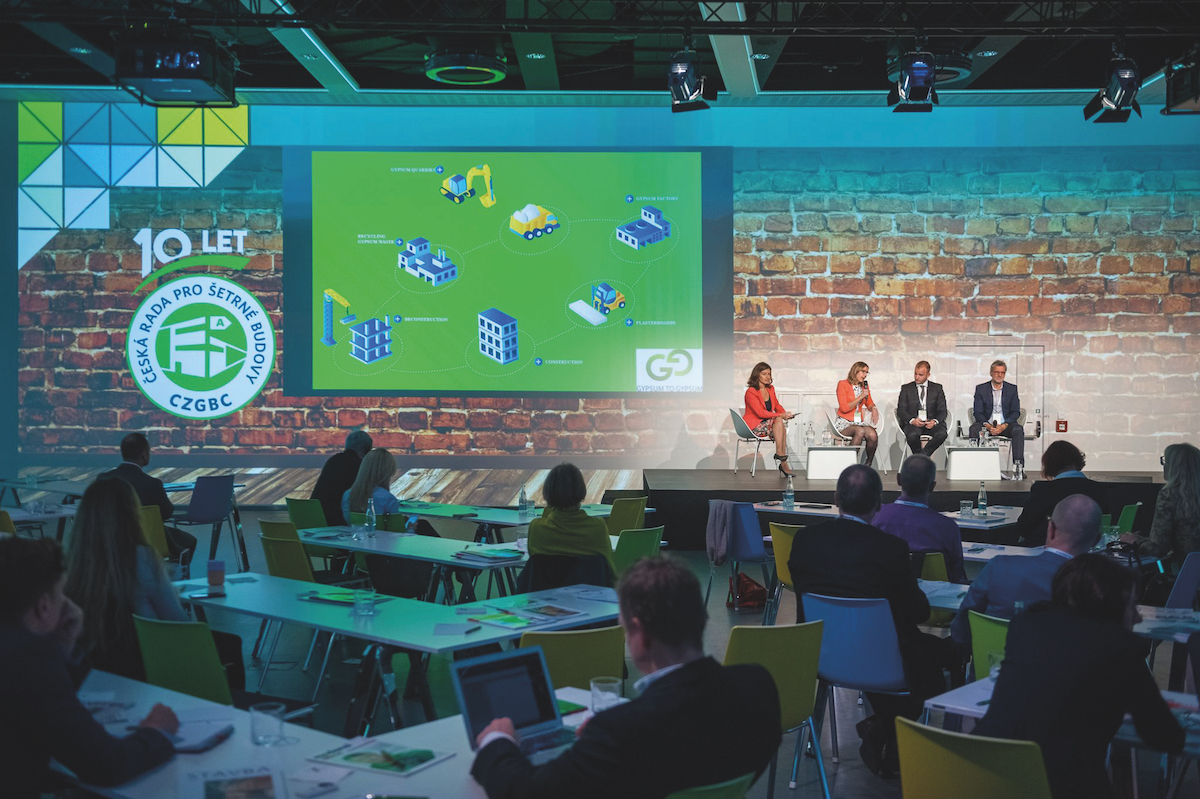We spend 90% of our lifetime in buildings

Text: Martina Hošková and M.Zisso; Photo: Archive
Is the construction industry a big environmental polluter? Do you know what the average age of a Czech residential building is? And have you ever heard of the New Green Savings grant program? Whether yes or no, you will sure find out while reading our interview with Simona Kalvoda, the head of the Czech Green Building Council, whose members believe in promoting the principles of sustainable building in the Czech Republic.

Simona Kalvoda, Executive Director of the Czech Green Building Council and Stephen King, former US Ambassador
The Czech Green Building Council was founded in 2009, and you became its director four years later. Can you tell us more about your goals and activities?
As a member of the World Green Building Council, our Council was founded by companies who felt the need for a common approach to the issues of sustainability in the building sector, promoting green standards, creating a better legal environment, and sharing knowledge.
You can find all kinds of companies among our members, from one-man-bands through SMEs to big corporations. We are open to any participants interested in sustainability and its promotion. Recently, we have welcomed the Embassy of Canada – the first of its kind, which have had their building in Prague certified for sustainable standards.
At the end of 2013, the Czech Council was looking for a new director, and within the course of events I got the job. I think my advantage was my previous work experience with the dynamics, advantages, and challenges of running a not-for-profit association financed primarily by memberships. And I have always been interested in environmental issues.

Conference Green Building
I believe our readers have an idea of what to think of when you refer to a “green building” or a “passive house”. However, can you offer further insight from the Council director’s point of view?
A passive house is designed, constructed, and operated in a way that uses minimum energy for heating, hot water preparation, and other systems. It is ensured by an optimized design at the very beginning of the project, and further supported by solutions such as proper insulation, quality windows, well-designed shading, use of renewable energy resources, etc.
It is not only passive houses, but also sustainable buildings in general, that represent the future. Unfortunately, the construction industry, although undergoing fundamental changes, is still one of the biggest polluters. It is responsible for up to 38% of global CO2 emissions. New buildings are already built with certain energy efficiency standards that meet the ambitious requirements of the Paris Agreement. However, the biggest potential for improvement and mitigation of the climate change impact can be found in already existing buildings. In the Czech Republic, the average age of residential buildings is 50 years old. It is assumed that 80% of the current existing buildings will still be here in 30 years. That is why the deep renovation of existing buildings is equally important as the designing of new ones.
The reality is that money always comes first, and therefore it is important to ask: is it more expensive to build a sustainable building?
Actually, if you take the “green” approach from the beginning (i.e. starting from the planning and design stage), the extra costs are negligible. What you invest in technology and solutions you will get back through long-term savings during the operation of the building. Furthermore, modern buildings are designed to provide energy efficiency, but, more importantly, they should ensure a comfortable and healthy indoor environment. This means that there should be a large enough supply of fresh air, good quality acoustics, well- balanced natural and artificial light, a sufficient level of humidity, and a comfortable temperature. We spend up to 90% (!!) of our lifetime in buildings, so all these aspects have a strong impact on our wellbeing.

Are the European Union and Czech government supporting this construction approach – not only rhetorically but also financially?
There is a number of both EU and local grant programs that support the use of sustainable solutions. They not only support energy efficiency and savings, but also quality indoor environment, green roofs or rainwater, and grey water management in both new and renovated buildings. The best-known local grant is called ‘New Green Savings’, which supports, among others, the construction of family and multi-family houses that meet the “passive” standards.
The Green Building movement strives to improve people’s quality of life. Can you give us your advice for creating a better quality of life?
Prioritize and enjoy every moment. We have the privilege of living a luxurious quality of life. In my case, I best relax on the golf course or the ski slopes, depending on the season. Or I simply laze around with my family and friends in our country house with a nice glass of wine. However, we should certainly think about the quality of life of our children and further generations too, and behave and act in a way that is preserving it for them.

